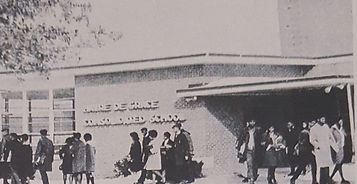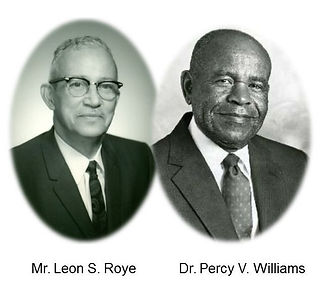
The History
“No man can know where he is going unless he knows exactly where he has been and exactly how he
arrived at his present place." - Maya Angelou


From the Beginning
In 1910, Harford County Government acquired the parcel of land on Stokes and Alliance Streets for the purpose of establishing a grammar school for African American students in Havre de Grace (HdG), Maryland. Called the HdG Colored School, it would become one of more than 14 grammar schools for African American children in Harford County during the era of Jim Crow. The lots in the parcel of land were owned by several individuals described as wealthy African Americans and white philanthropists. These individuals included Peter Leslie Hopper, A. Hamlin Carver and his wife Nettie J. Carver, and Samuel J. Ennis and his wife Annie Ennis, who sold the parcel to the Board of County School Commissioners on April 22, 1910 for a nominal sum of $10.
A news article in the June 29, 1912, Cecil Whig , stated, “The colored people of HdG have raised $2,000 towards a new colored school building which is to be built in that town during the summer months.” The school (a white wooden-framed structure) was formally opened in December of 1912 at a cost of $1,700 with $200 of that donated by the City of Havre de Grace [Baltimore Afro American Ledger, December 27, 1912]. The Ledger further listed comments that “Mr. and Mrs. Lloyd Smith donated a beautiful clock, and a promise of a flag was made.” Mr. Abel Cromwell was named as the principal and Miss Cora I. Newsome as the vice principal.

Mr. Abel Cromwell

"Colored" grammar schools in Harford County
Educating Students
Although public high schools existed in Harford County since 1896, Harford County policy provided education for African American children only through grade seven and then later to grade eight. As a result, African American students seeking a secondary education had to travel to Baltimore, Cecil County, Philadelphia, or other locations outside of the county to obtain a public high school education. Leading the way were community leaders and educators such as Abel Cromwell, Blanche Caswell, and Dennis W. Noble [Supervisor of Colored Schools]. Based on their collective efforts and activism, these pillars of the community provided some high school level classes at the HdG Colored School without pay or compensation from the County.
The Establishment of The Parent-Teacher Association (P.T.A.)
In 1924, the former HdG Mayor, George T. Pennington, chaired a committee that included State Senator, Millard E. Tydings; Rev. John R. Barnum, Pastor of St. James A.M.E. Church; the Honorable Robert Lawder and Frederick Cobourn, members of the HdG City Council, to consider options for the establishment of a high school for African American students.
In 1930, through the efforts of Mr. Nobel, concerned citizens organized a county-wide Parent-Teacher Association (P.T.A.) and named Mr. Clayton C. Stansbury, Sr. (1893-1962) to serve as P.T.A. President and Mr. J. Leo Jones as secretary. Based on this initiative and the efforts of Mr. Stansbury, the Colored P.T.A., and community leaders like Mr. Vandellia Williams, Harford County agreed to establish its first public high school for African American students. In 1930, the county selected HdG as the location and named it the HdG Colored High School.

The Colored P.T.A

Mr. Dennis W. Nobel

Mr. Clayton C. Stansbury

Mr.Vandellia Williams




Mr. Leon S. Roye and The First Class
The school board selected Leon Stansbury Roye (1905-1966) as the principal of the high school. This selection made him the first African American principal in Harford County, in which he served from 1930 to 1965. The first graduating class from the HdG Colored High School was the class of 1932. To accommodate the high school students, the County erected a small four-room brick building to adjoin the existing 1912 white-framed primary school building. The four additional rooms were not completed until 1936.
Although African American children had a new school, they still had to rely on outdated and second-hand books and equipment handed down by schools attended by white children. Despite the limited access to quality educational materials, Mr. Roye and the teachers endeavored to ensure students graduated with a high-quality education
Succeeding Against the Odds
Just as sports figures like Jackie Robinson and Jesse Owens helped to break the color barrier, sports also played a significant role and placed the HdG Colored School in a prominent place of recognition within the County. Although the school did not have a sports facility, the student athletes of the Colored School were highly regarded for their athletic prowess. Relying on the use of the school's surrounding streets as a makeshift track and field, their women's and men's teams demonstrated exceptional achievement and recognition in sporting events Students at the Colored School were also privileged to have James M. Langston Hughes (1902-1967), a renowned African American poet, novelist, playwright, and social activist, to grace the hallways of the HdG Colored School. Better known simply as Langston Hughes, a member of the Omega Psi Phi Fraternity, Incorporated, was a close friend and fraternity brother of the school's principal, Mr. Roye.

"Colored" grammar schools in Harford County

Educating Students
In 1953, HdG Colored Schools, both elementary and high school, were moved to 201 Oakington Road, HdG, and were combined with other area grammar schools and renamed the HdG Consolidated School. There, the HdG Consolidated housed all grades-grade one through grade twelve.
In 1954, the landmark Supreme Court decision, Brown v. The Board of Education ruled that sanctioned segregation of public schools was a violation of the 14th amendment and was, therefore, unconstitutional. It was not until 1965, 10 years after this landmark decision, that schools in Harford County were fully integrated. The school year 1964-65, would mark the final segregated graduating class of the Havre de Grace Consolidated School. During the period of integration, the county renamed HdG Consolidated to Oakington Elementary. Currently, the school is named Roye-Williams Elementary School after the former principal of the HdG Consolidated School, the late Mr. Leon S. Roye, and the former principal of the Bel Air Central Consolidated School, the late Dr. Percy V. Williams.
The Establishment of The Havre de Grace
Colored School Museum and Cultural Center, Inc.
In 1972, the Harford County Board of Education sold the former Colored School and adjoining buildings to the Harford County Commissioners. The property was acquired at auction by Dr. Gunther Hirsch (1925-2015), a former physician and Mayor of HdG. In 1986, the property was sold to the DEE General Partnership, consisting of Dr. Hirsch’s three daughters.
Dr. Hirsch had always been known as a friend to the African American community, the HdG Colored School, and their leaders. In 2005, with the changed name to Alliance 555, LLC, the Hirsch family renovated the buildings as medical offices with a reception area and examination rooms. The buildings were vacated 10 years later, and in 2018 were acquired by The HdG Colored School Foundation of Community Projects of HdG (CPoHdG), Inc., through the donation of a portion of the cost of the building by the Hirsch family. The Foundation is currently organized and named The Havre de Grace Colored School Museum & Cultural Center (HCSMCC), Inc. On February 21, 2019, CPoHdG formally transferred the property to the ownership of the HCSMCC.
The HCSMCC’s mission is to remember, promote, and preserve the history and legacy of the HdG Colored School. The communal body of these men and women deserve great credit for not losing sight of their goal of attaining the school, which has fostered the current success of the HCSMCC. That is the story of this institution’s remarkable journey from a grammar school established in 1912, to a high school in 1930, and now a museum and cultural center established in 2018.



Dr. Gunther Hirsch


Harford Mutual Insurance Group's Donation
That Helped to Acquire the School
Cameo: Janice Grant
By Amy Mulvihill, the Baltimore, February 2013
"I went to Havre de Grace Colored High School. Not many people of color actually finished high school. Believe it or not, they couldn’t afford to pay to ride the train to Havre de Grace. It was something like 15 cents, but if you didn’t make much money—[if] you did housework or something like that—and [if] you had four or five children, that amounted to quite a bit of money. [L]ater, the County did supply a bus. . . . I know it’s hard to imagine, but at that time, it was quite a feat for everyone to finish high school."
